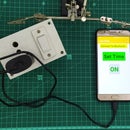Introduction: Smartphone Accelerometer Controlled Cardboard Maze
In this Instructable, I made a cardboard maze that is controlled by using Smartphone Accelerometer Sensor.
it uses a smartphone accelerometer as a sensor.
Supplies
Step 1: Printing and Cutting Design
Print the design in A4 Sheet .as some sheet is greater than A3 Size sheet so print them in parts.
then cut out sheet according to marks, here dark line indicates cuts and the dotted line indicates paper folds.
Step 2: Cardboard Cutting and Pasting
Take some Cardboard sheet and paste the design sheet over it. you can use any paper pasting glue for this. cut out all dark lines and the resulting product looks like those images.
Step 3: Creating Structure for Both X and Y-axis Servo Motors
Next, fold the cardboard sheet according to the (------------) dotted line and the resulting product are these two cardboard structures. one for the X-axis servo and another Y-axis servo. I used wood nails for extra support.
Step 4: Creating Maze Tracks and Placing Servo Motors
Cutout 20cm x 1cm cardboard strips (here length does not matter it's up to you) paste them according to the maze track with paper pasting glue. Place servo motor by using hot glue gun and place screw at another end, both servo and screw are in the same line.
Step 5: Making Wooden Stand for Our Cardboard Maze
Cut out the plywood according to dimensions shown in the images and remove a square-shaped hole for servo placement.
Step 6: Now Come to Connection and Coding Part
Arduino BT module
GND ------- GND
VCC ------- 5V
TX-O ------ pin0
RX-I ------ pin1
Servo-1&2 Arduino
GND(1&2) ------------ GND
VCC (1&2)-------------5V
Signal (1)---------------pin3
signal (2)---------------pin5
I created the android app in MIT app Inventor but it was unstable so used roboramo app.
You can download it from play store






